Edible and Medicinal Plants of North Idaho
Many of our North Idaho plants have some edible or medicinal value. This guide highlights any historical importance to Native Americans and early explorers in the plants's edible and medicinal properties. The narrations also give a basic description of the plant and its habitat.
Please note that these edible and medicinal values are furnished as historical information only and we are not encouraging any harvesting of native plants for food and/or medicine for several reasons:
- A positive identification of a plant must be made before tasting it. There are many poisonous plants that are very similar in appearance to edible species.
- Plants found along the roadsides may have been sprayed with chemicals or may contain possible toxic lead fumes from motor vehicles.
- Widespread collecting or harvesting our native plants, with the human population as large as it is today, can place plant populations at serious risk of becoming overused, possibly to the point of extinction.
- Native plants should be used for food only in an emergency situation and only if you can make a positive identification of the plant.
We would like to emphasize the importance of not picking or collecting wildflowers. Several of our wildflowers are rare or sensitive species or are at risk of becoming threatened. Appreciating these exquisite forms of nature can be accomplished in many ways besides collecting such as: drawing, painting, photographing, or just enjoying their aesthetic beauty in their natural habitat.
It is our hope that this guide may stimulate an interest and awareness of what Nature has to offer and make a trek through the North Idaho forests a more enjoyable experience.

Edible value: The bulb of the Camas can be eaten at any season, but is at its best in autumn. [Note: One should know the difference between this Camas and the Death Camas (Zigadenus), both in and out of bloom, before they consider eating any Camas.] With a potatoe-like flavor, the boiled bulbs are slightly slimy and gummy but are less mealy than potatoes. The bulbs can be baked, roasted, dried or eaten raw. Many Northwest Indians used Camas bulbs as their principal sweetening agent.
Camas probably played a more significant role in early western history than any other plant. It was a chief vegetable diet of Indians in the Northwest as well as trappers and early settlers. Camas was used extensively by the Lewis & Clark expedition and, at times, they were entirely dependent on it as food. The need of this plant enticed Chief Joseph and the Nez Perces to leave the reservation to collect them. This infraction instigated the Chief Joseph War. Father DeSmet referred to the Camas as the "queen root of this clime."
Habitat: Camas grows in moist meadows and along stream banks. They bloom from the middle of April to the middle of June, depending on altitude.
Description: Camas has bright blue, and occasionally white flowers, that form a showy raceme. They have 3 sepals and 3 petals which are similarly colored and 6 stamens. Camas can grow 1-2 feet tall with basal grass like leaves. The onion-like bulb is covered with blackish coats but are white inside.

Edible and medicinal value: Indians used wild onions extensively. Their bulbs served as a staple and condiment to many different tribes. The crisp bulbs were gathered by Indians from Spring through early Fall. They were eaten raw and used as an ingredient in soups, stews and meat dishes. The bulbs also stored well for winter use.
Onions were by explorers and pioneers as well. The men of General George Crook's 1876 starvation march down the Yellowstone River partially survived on certain species of wild onion. Lewis & Clark also found them a welcome addition to a meat diet.
A few Indian tribes would crush the wild onion and apply it to bee and insect bites to reduce swelling and pain. Others used it to draw poison out of snakebites. A heavy syrup made from the juice of the wild onion was also used for coughs and other cold symptoms.
Wild animals such as bears, ground squirrels, and marmots also dig these bulbs. Milk cows that eat the foliage of the onion produce onion-flavored milk.
Habitat: Wild onions grow in dry to moist soil in valleys, open hillsides and ridges.
Description: The Shortstyle Onion has 2 leaves shorter than the stem which sheath at the base of the flower stalk. The sepals and petals together number six. The stamens are shorter than the pink sepals and petals. The leaves and stalk, as well as its bulb, have a characteristic onion flavor and odor.

Edible and medicinal value: The Fireweed, also called the Great Willow-Herb, has an abundance of vitamin C and was used by Indians and settlers who picked and boiled the fresh green sprouts in springtime. A tea was also made from the leaves.
Indians and pioneers made an extract from boiled roots of the fireweed and placed it on swellings.
Habitat: Found in fairly rich soil in open woods and thickets as well as along streams. It is one of the first plants to invade disturbed soil such as in cultivation or forest fires. It is called Fireweed because of this ability to move in and cover up the scars of forest fires and also the flower's resemblance to a flame.
Description: Fireweed has its' 4-petaled flowers in an elongated flower cluster where the flowers bloom first at the bottom and work up the flowers bloom first at the bottom and work up the flower cluster. These flowers are bright pink to rose-colored. Leaves of the Fireweed are lance-shaped. Fireweed is a valuable forage plant for game species such as deer and elk. It is also a favorite forage of grizzly bears.

Edible and medicinal value: The aromatic stems and roots of the Wild Ginger were used by early settlers as a substitute for the tropical ginger.
The Indians used a decoction from the dried roots to induce abundant sweating and for fever-reducing purposes. A few Indians also steeped the leaves to reduce fever.
The roots were bound to cuts or wounds to stop bleeding and promote healing. Some tribes used the root for respiratory problems, especially lungs, and for earaches. Roots dried and powdered between two smooth rocks were used as a snuff to ease a headache.
Habitat: Inhabits cool, moist shaded woods.
Description: The heart-shaped leaves of the Wild Ginger are the first noticeable trait you see. A closer look towards the bottom of these leaves reveals a brownish-purple flower with petal-like lobes that start with a bowl-like base and slender out at the tips.

Edible and medicinal value: This plant was introduced in America by the early colonists and spread rapidly -- soon Indians were using it as a food source. The large fleshy taproots taste like parsnips when cooked. Some say the roots taste like oysters and that is why the Salsify is also sometimes called the Oyster-plant. The roots, when roasted and ground, are considered by some as a coffee substitute.
Indians and settlers believed that the milky juice of the Salsify was useful in dissolving gallstones. They would also extract the milky juice, wait for it to curdle, and then chew it. This was used to keep the mouth moist and also to aid in digestion. An extract from simmering roots was used to relieve indigestion, heartburn, poor appetite, and liver trouble. Extracts were also used for sore eyes. Young roots washed, scraped, and cut up raw in salads were believed to be good for the stomach.
Habitat: The Salsify can be found in medium-dry to moist soil along roadsides and fences.
Description: The yellow flower heads are borne on tall, leafy stems and mature into a head resembling that of a fluffy, giant dandelion head.

Edible and medicinal value: The fruit of the wild Rose, or rose hips, can be eaten raw or stewed. These fruits can also be found on the plant during the winter when other fruits are unavailable.
North American Indians had a variety of medicinal uses for the wild Rose. They even believed that in breathing the roses' sweetness one would enjoy a happy, soothing and relaxing feeling. Flowers soaked in rain water were used to bathe sore eyes as well as applied to aching foreheads to ease discomfort.
A tea was made from the petals of the rose and, combined with mint, was taken internally for sleep and relaxation. From scrubbed roots of the Rose, a tea was made and believed to be effective against coughs.
Rose hips contains more vitamin C than an orange and the seeds are rich in vitamin E.
Habitat: Inhabits moist soil of draws, hillsides, along streams, and in open valleys.
Description: This 3 to 10 foot shrub has prickly branched stems and toothed leaves. The pink flowers which are 1 ½ to 2 ½ inches across have 5 sepals and 5 petals with many stamens and pistils.
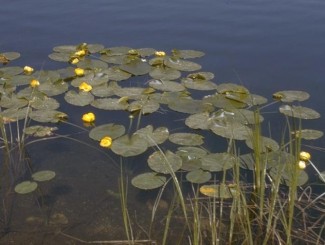
Edible and medicinal value: The mature seeds of the Yellow Pond Lily can be placed in a frying pan on an open fire and they will swell and pop open resembling popcorn in appearance and taste.
The roots may be boiled or roasted, peeled, and then eaten as is or placed in a soup or stew. The core of the root is rich in starch. The root was also dried and ground into a meal and then made into a flour by the Indians.
The Indians, however, had difficulties in gathering this particular plant for food and medicine. The fleshy root stocks grow under 4 to 5 feet of water. Some Indians would raid caches of the roots in muskrat houses, but usually they would dive for the root.
Baked root stocks of the Yellow Pond Lily were sliced and used as a poultice for sores. A decoction made by boiling root stocks was added to bath water to treat rheumatism.
Habitat: The Yellow Pond Lily's leaves and flowers can be found floating on the surface of quiet streams, ponds, and shallow lake shores.
Description: This large-leaved water plant has bright yellow, waxy flowers that can be up to 5 inches across.

Edible and medicinal value: This plant is truly the pantry of the outdoors. Young spring shoots can be pulled and the outer leaves peeled away so that the tender inner portion can be eaten raw. The Cattail flower spikes can be boiled and eaten just like corn on the cob. Pollen from mature flowers can be collected and used with other flour to make pancakes, muffins, or biscuits. The root can also be dug, boiled or baked, and made into a flour. The leaves of the Cattail were used to make floor mats for a tipi or lodge.
Some Indians would use the downy fruits to make a dressing for burns and scalds. They also used the down, as we would talcum powder, on infants to prevent chafing. Smallpox was even treated with a mixture of coyote fat and the downy material by applying it to the sores.
The Cattail can also be used as a source of survival. The flowers are excellent tinder. The fuzz explodes into flames and can be used to start a fire. The down can also be used as insulation in boots or jackets to prevent frostbite.
Habitat: Familiar plant of swamps, ponds and edges of streams and other marshy habitats.
Description: Cattails have light green, flat leaves. The flowers are in a dense, brown spike at the top of a 4 to 8 foot stem.
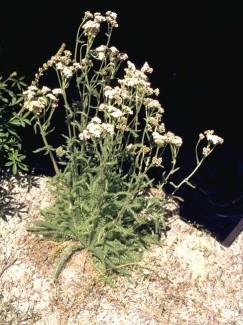
Medicinal value: Yarrow is considered a medicinal wonder. It has been used to stop bleeding of wounds and cuts; as a poultice for burns and open sores; used to cure fevers and colds; and alleviates toothaches.
The leaves were mashed with water and put on wounds. The Indians believed that it acted as a disinfectant and promoted healing. Pharmacists have extracted an alkaloid chemical from the plant and called it achillein, after the plant's genus name. This chemical actually reduces the clotting time of blood. There are accounts that even Achilles, for whom the plant is named, used it to stop bleeding wounds of his soldiers.
A tea made from the leaves was used for fevers and colds. The leaves can be crushed in your hand, mixed with water, and put on a sunburn.
Habitat: A common plant found in dry to moderately moist soil in sunny areas.
Description: Yarrow has a flat-topped flower cluster consisting of numerous minute white flowers. The leaves have a fern-like appearance and are intricately divided. This plant has a strong scent.

Edible value: Evert's Thistle is named for Truman Everts who was among the 1870 party exploring Yellowstone Park. He actually owes his life to thistle. During the exploration he became separated from his companions, was thrown by his horse, and broke his spectacles. He was unable to hunt game as he was extremely nearsighted without his glasses and he had no horse. Because he was starving to death, he began eating thistle roots, which he existed on until he was rescued a month later.
The tender spring stems of this thistle have a sweet delicate taste. They can be eaten raw once the spiny covering has been peeled away. Flathead Indians liked the thistle so much that they imposed a taboo to prevent people from over picking this plant.
Habitat: The Evert's Thistle likes moist to wet soul and is usually found in open meadows in valleys and higher elevations up to 8,000 feet.
Description: This thistle generally stands above other vegetation in meadows. It stands up to 4 ft. in height and has white to purple flowers clustered at the top of the plant. The entire plant, including the toothed leaves, is covered with spines. The stem of this thistle is almost as thick at the top as it is at the bottom.
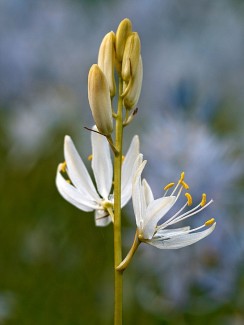
Edible and medicinal value: The berries were a chief food in the Indian diet. They would make a staple called pemmican from the pounded, dried berries and dried buffalo meat. The Flathead Indians would form patties and loaves from the pounded fruit. They would then powder the leaves of horsemint and field mint and sprinkle the powder over the patties to keep flies away. Lewis & Clark made note that some serviceberry loaves weighed as much as 10-15 pounds. Serviceberries also make excellent pies, jellies and wine. The stems of the serviceberry was one of the preferred materials for arrow shafts. The fruit of this plant is also a prime morsel for many woodland inhabitants such as birds, bears, chipmunks and other small mammals.
Habitat: Found in moist soil along streams and in mountains to about 7500 feet. Small, brushy varieties grow on fairly dry hillsides.
Description: The key features of the Serviceberry are its roundish leaves with teeth at the end; clusters of fragrant blossoms in spring; and red or black seedy berries. The Serviceberry is a shrubby plant varying in height from 3 to 20 feet. The small white flowers resemble apple blossoms in appearance and fragrance and are abundant in May. The fruit of the Serviceberry are red or black and contain several seeds.

Edible and medicinal value: Western Indians prepared a tea from the green leaves of the Strawberry plant. They also made use of the tiny, sweet fruit of the Strawberry.
Indians ate wild Strawberries for colds even before vitamin C was known. Juice from the wild Strawberry was mixed with water and used to bathe reddened eyes. This juice was also squeezed into inflamed sores and often showed healing effects. It was also used to relieve sunburn. A tea made from dried leaves was used for kidney trouble and relieving stomach trouble.
Minutemen from the American Revolution were saved from scurvy by drinking a tea made from the fresh green foliage of the wild Strawberry.
Indians would make bitters from wild Strawberry roots and use it as a tonic and blood purifier after a long cold winter. Wild Strawberries were mashed into a paste to remove tartar and clean teeth and was also used for toothaches.
Habitat: Found from the lowest valleys to timberline in moist soils of woods, open meadows and along streams.
Description: The leaves of the Strawberry have 3 toothed leaflets. The flower has 5 white petals. The red fruit is that of a typical strawberry only much smaller in size.

Edible and medicinal value: Mint was used by different Indian tribes in various ways. Several tribes used mint tea for colds, coughs, and fevers. The mint leaves were used to treat rheumatism and arthritis by the Kutenai Indians. Flathead Indians packed the leaves around a decayed tooth to bring relief. Cheyennes would use it as a perfume -- they would chew the leaves and put them on their bodies. Other tribes used the powdered leaves on meat and berries to repel bugs.
Mint was also used as a flavoring for meats, vegetables and soups.
Habitat: Inhabits damp soil -- wet woods and near stream banks, springs and bogs.
Description: The most obvious identification feature of the Mint is its strong odor. This plant grows from one to three feet with small light blue or light pink flowers which cluster in the leaf axils (the upper angle formed by the leaf and the stem). The stems of the Mint are square and its finely toothed leaves are attached opposite each other.
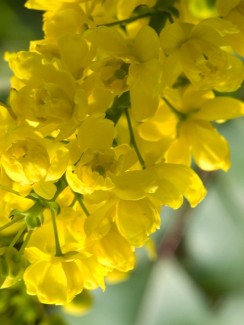
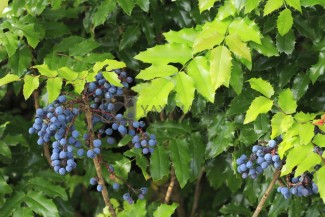
Edible and medicinal value: Indians and pioneers used the Oregon grape as medicine, food, drink and as a source for a dye. The cleaned, crushed root of this plant was known for its antiseptic properties and was used by the Flathead Indians to clean wounds and cuts. the Kutenai Indians drank a tea made from the root to enrich their blood. This particular Indian tribe also used a tea made from the roots for kidney troubles. The National Standard Dispensatory, a reference book of pharmaceutical plants, lists many uses of Oregon grape but warns that an overdose can be fatal.
Oregon grape berries are edible but are extremely sour. Once sugar was introduced to the Indians by the pioneers, the Indians would make a tasty dessert by mashing the berries in a bowl and adding sugar and milk. Some tribes made a drink from mashed berries, sugar and water.
The roots were used to make a brilliant yellow dye. the dye was made by boiling the shredded bark of the root and was used for clothing and basket work.
Habitat: Found in lower foothills and wooded mountain slopes in moderately dry soil.
Description: The Oregon grape is a small evergreen shrub which seldom grows more than a foot tall. The holly-like, spine-tipped leaves are a shiny green which turn to deep red in the autumn. It has clusters of bright yellow flowers that, by late summer, develop into dark bluish-purple berries.


